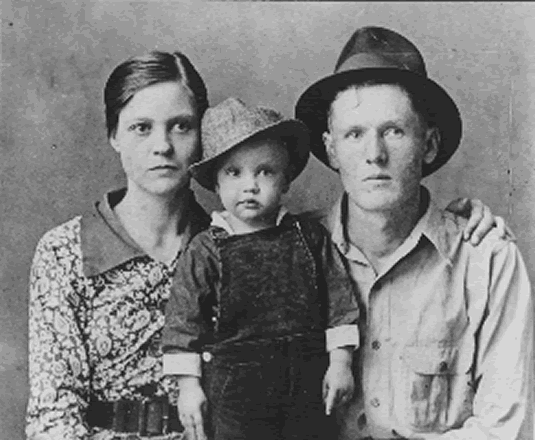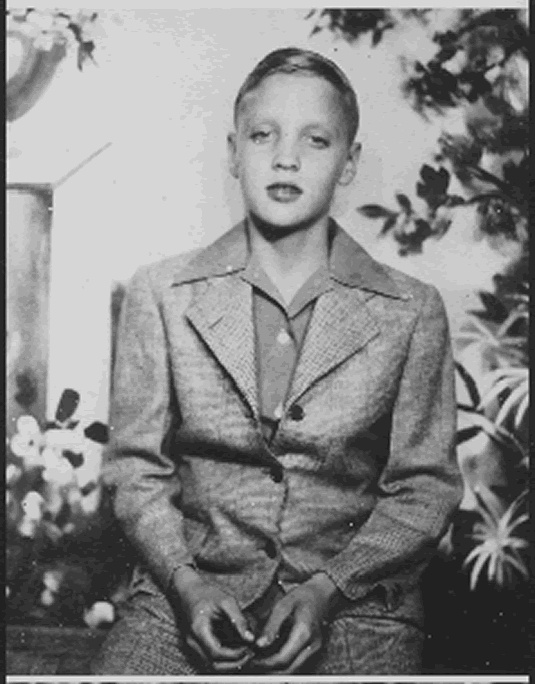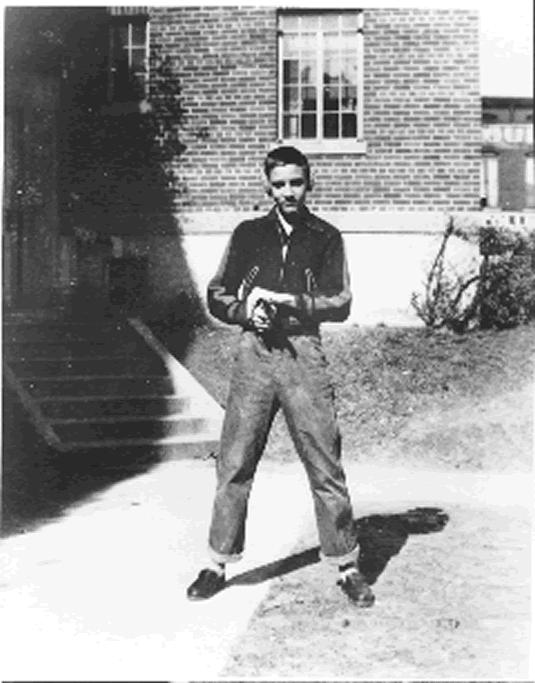1935: Elvis is born
Elvis Presley was born in Tupelo, Mississippi, on January 8, 1935, in a two-room shotgun house in East Tupelo, then a separate municipality that some called the “roughest town in north Mississippi.” Though poor, Elvis’s parents, Gladys and Vernon Presley, were not unlike many others in Mississippi at that time, for the country was in the midst of the Great Depression. The unemployment rate in the United States in 1935 was 20.1 percent.
Times were hard in the U.S., especially in the South, when Elvis Presley entered this world. To be born poor then was not unusual. What was unusual about Elvis at his birth is that he was a twin. His twin brother, Jesse Garon, did not survive, making Elvis what is called today a “twin-less twin.” Elvis was cherished by his family, but psychologists say that losing a twin can deeply affect the baby’s mother and the surviving twin. Elvis no doubt later yearned for a brother to help him through the rough spots of his life — of which there were many. Elvis later changed his middle name, Aaron, to Aron, to more closely match his twin’s middle name (Garon). Elvis’s mother — a strong and supportive presence in his life — told the young Elvis that a surviving twin gets the strength of both children, and all evidence indicates that, in this case anyway, she was right.
The shotgun house Baby Elvis called home, the “Birthplace Home of Elvis Presley” in Tupelo, was built by his father, his uncle, and paternal grandfather. It is visited by thousands of people from all over the world. (“You can take this birthplace and put it in my living room at Graceland,” Elvis later said.) But what these thousands of visitors do not realize is that Elvis lived not only in that two-room shotgun but in houses all over Tupelo.
They lost the shotgun house in 1938 when Elvis’s father and two other men went to Parchman Farm—the Mississippi State Penitentiary— to serve eight months for altering a four-dollar check. Elvis and his mother moved in with relatives in Tupelo. His father’s imprisonment
was traumatic to three-and-a-half-year-old Elvis, who, according to a cousin, would sit on the porch “crying his eyes out” for his daddy. Often Elvis and Gladys took the bus to Parchman on the weekends to visit him. After release from Parchman, Vernon, as a day-laborer, had to continue to support his mother as well as his family; as a consequence, the Presleys were to become renters, like many families, moving from one affordable space to another. The constant in their lives was church — Vernon and Gladys had met at the Assembly of God Church and they continued to attend church there, where music was becoming a big attraction to little Elvis.
The next year, at age four, Elvis, overhearing his parents fret about paying the bills, revealed his specific plans for looking after his family — in style. He announced for the first time (there were many similar announcements to come) that he was going to buy two Cadillacs, one for his mother and father and one for him.
1941: Elvis starts school
Elvis started elementary school at the East Tupelo Consolidated School on Lake Street. He was termed “sweet and average” by his teacher. His mother walked him the half mile to school each day. He got his first guitar lesson from Frank Smith, the new young pastor at the church they attended, and apparently Elvis took to these lessons more than he did those at school. A photograph taken in 1942 when he was seven shows Elvis and his parents looking straight into the camera, not posing or smiling, but rather looking with pride toward the photographer. Gladys Presley has a look of optimism. Vernon Presley, a handsome man, is wearing a leather jacket, his large, strong hand draped around the shoulder of a thin, growing Elvis. The dashing Vernon may have been one of the inspirations for Elvis’s later flair. (Elvis and Gladys author Elaine Dundy reports that Elvis was also a huge fan of the comic-book superhero Captain Marvel Jr., and copied his hairstyle and outfits.)
Oleta Grimes, one of his teachers, was impressed by Elvis’s musical talent and took him to the principal, who entered Elvis, age ten, in a radio talent contest at the Mississippi-Alabama Fair. On the appointed date, Elvis surprised his mother by going onstage and climbing up on a chair to reach the microphone to sing “Old Shep” in front of several hundred people. He won fifth prize, according to Elvis biographer Peter Guralnick. The next year, when Elvis wanted a bicycle Gladys Presley talked him into a less expensive item, a guitar for $12.95 from the Tupelo Hardware Company, not only because of its price but also because the overly protective mother feared Elvis would hurt himself on a bicycle. He began taking the guitar with him to school every day, sometimes playing a little music— gospel music—for his friends.
1948: Elvis moves to Memphis
In the fall of 1948 the Presley family was on the move again, and this time they decided to leave Tupelo and go north, to the city of Memphis, Tennessee. It turned out to be a lucky move for an ambitious and musical young man. It was an optimistic time for the country: the Second World War was over, and unemployment was down nationally to 3.9 percent. For Elvis and other music lovers, 1948 was notable because Columbia Records introduced the 33 1/3 LP (“long-playing”) record.
In Memphis, after a time, the Presleys were able to get a downtown apartment through the housing authority at Lauderdale Courts, a 433- unit complex. They had plenty of room there, and Elvis made friends in this town full of music with other young people who were interested in music. Nearby were Beale Street and the Ellis Auditorium, offering national acts. The Handy Theatre was offering all the practitioners of “city blues”—Wynonie Harris, Bobby “Blue” Bland, and others—as well as jazz. The Blackwood Brothers, the top gospel group in America, had just moved to Memphis.
What music was not live in Memphis was on the radio. Famed disc jockey Dewey Phillips at WHBQ was playing blues as well as rhythm and blues, or R&B; B.B. (The Blues Boy) King was playing more blues at WDIA; the country blues—Sonny Boy Williamson, Howlin’ Wolf, and the rest— was coming in from West Memphis; and WHHM had country music covered.
At Humes High newcomer Elvis reinvented himself—or perhaps he was just being a teenager of the 1950s. He set himself apart, styling with such fashion elements as dress pants (often with a stripe down the side) a bolero jacket, and sideburns. Elvis was a contemporary of film actor James Dean, after all, and a huge fan of Rebel Without a Cause. He apparently shopped for some, if not all, of his clothes down on Beale Street.
He took his guitar to school there too—when some rough kids cut the strings on it, other classmates chipped in and bought him a new set. Elvis took more guitar lessons, tagged along with his guitar teacher and played in his band, had a steady girlfriend, and worked odd jobs after school and summers. Jerry Schilling, a friend of the teen-age Elvis, describes him as a “voracious reader,” “very spiritual,” and “a lovable rebel.”
1953: Elvis graduates high school
In April of 1953 Elvis performed as one of twenty-two acts in the Humes High “annual minstrel show.” In the first volume of his biography of Elvis, Last Train to Memphis, Peter Guralnick quotes him: “Nobody knew I even sang. It was amazing how popular I became after that.” Elvis graduated from high school that year and eventually got a job driving a supply truck for Crown Electric. In 1953, an armistice had ended the fighting in the Korean War, and unemployment was 3.0 percent.
In August 1953, eighteen-year-old Elvis went down to the Memphis Recording Service on Union Avenue, home of Sun Records and run by Sam Philips, friend of disc jockey Dewey Phillips, to make a record. Like Elvis, Sam Phillips was passionate about music, especially the music “that white people liked but weren’t sure whether they ought to or not.” Elvis cut a record that day for $3.95, and Phillips told him he’d call him back. Phillips didn’t call, though, and in 1954 Elvis went back and cut another record. On Saturday, June 26, 1954, Elvis got a call from Marion Keisker, who worked at Sun Records, in a story that is now world famous, asking if he could “be here by three.” “I was there by the time she hung up the phone,” Elvis said later.
That first session didn’t work out so well, but during July Elvis and guitarist Scotty Moore and bassist Bill Black—after a slow start—hit on something while they were just fooling around. It was a speeded-up version of Mississippi crooner Arthur “Big Boy” Crudup’s “That’s All Right,” and when Phillips heard it, he interrupted them, asking “What was that?” They could not tell him exactly, so they just played it again. It was exactly the music Sam Phillips had been looking for, although he had been unable to tell them how to get there.
Sam’s brother Dewey was sold on the music too, and when he played it on his Red, Hot, and Blue radio show at WHBQ, the listeners went wild. Dewey was kept busy on the telephone taking request after request for the song.
When the debut single of “That’s All Right” was released — with “Blue Moon of Kentucky” on the flip side — it sold like crazy, and a national phenomenon was born. Elvis was nineteen.
The group appeared for the first time on the Louisiana Hayride, a live Saturday-night country music radio show, on October 16, 1954. The next year Elvis signed the now-famous RCA contract — for an unprecedented $40,000 — and RCA re-released the five Sun Records singles on its label.
1956: 60 million watch Elvis on TV
Several high-profile television appearances followed, and in the fall of 1956, Elvis performed twice on The Ed Sullivan Show. The first, on September 9, 1956, drew sixty million viewers, more than eighty percent of the national TV audience.
That year American teenagers began to buy the new portable transistor radios, a boon to spreading the new music, especially rock and roll, to young fans. When Elvis played the Mississippi-Alabama Fair in 1956, a hundred National Guardsmen were on hand to control the crowds of fans—especially the girls, who screamed out of control when Elvis sang. Scotty Moore told him why: “It was your leg, man. It was the way you were shaking your left leg.” Later a reporter asked Elvis if he thought he might get rid of some of that “wiggle,” and Elvis replied, “Well, sir, you take the wiggle out of it, and it’s finished.”
Elvis Presley went on to sell more than 500 million records worldwide and to revolutionize American popular music. Despite his fame — and a hot temper — his friend Schilling writes that Elvis chose “ninety percent of the time to be a nice guy.”
And, Elvis Presley kept the promise he made at age four—he bought his family a Cadillac in 1957 and went on to buy many more. He never forgot his hometown of Tupelo, either: during the 1960s he generously donated funds to create a ball park, swimming pool, and community center.
Elvis died at Graceland Mansion from a heart attack August 16, 1977, at age forty-two. He is known as the King of Rock and Roll.
Christine Wilson is director of publications for the Mississippi Department of Archives and History, and managing editor of the Journal of Mississippi History, the quarterly publication of the Mississippi Historical Society.
Lesson Plan
-

(c) Elvis Presley Enterprises, Inc. The cherished Baby Elvis with his parents, circa 1938. Used by permission, Elvis Presley Enterprises, Inc. -

(c) Elvis Presley Enterprises, Inc. Elvis and his parents look with pride toward the photographer, circa 1942. Used by permission, Elvis Presley Enterprises, Inc.
-

(c) Elvis Presley Enterprises, Inc. Elvis, circa 1943, with wagon. Used by permission, Elvis Presley Enterprises, Inc. -

(c) Elvis Presley Enterprises, Inc. Elvis at about age 11, near the time his mother bought him a guitar at the Tupelo Hardware Company. Photograph circa 1946. Used by permission, Elvis Presley Enterprises, Inc. -

(c) Elvis Presley Enterprises, Inc. Elvis a year after the family moved to Memphis. Photograph circa 1949. Used by permission, Elvis Presley Enterprises, Inc. -

(c) Elvis Presley Enterprises, Inc. Promotional photograph for "Loving You" in 1957. From the time Elvis received a guitar in his youth, the guitar became an extension of him. Used by permission, Elvis Presley Enterprises, Inc. -

(c) Elvis Presley Enterprises, Inc. Promotional photograph for "Jailhouse Rock" in 1957. Elvis was a huge fan of movie star James Dean and of Rebel Without a Cause. Used by permission, Elvis Presley Enterprises, Inc. -

(c) Elvis Presley Enterprises, Inc. Elvis performed twice on television’s "The Ed Sullivan Show" in the fall of 1956. The first appearance on September 9 drew 60 million viewers, more than 80 percent of the national television audience. Used by permission, Elvis Presley Enterprises, Inc.
Sources
Books
Guralnick, Peter. Last Train to Memphis: The Rise of Elvis Presley. Boston: Little Brown, 1994.
Sandbank, Audrey C. Twin and Triplet Psychology: A Multi-Professional Guide to Working with Multiples. London and New York:
Routledge, 1999
White, Timothy. “Elvis Presley,” Rock Lives: Profiles and Interviews. New York: Henry Holt and Company, 1990
Newspaper
Rohter, Larry and Tom Zito, “Rock Idol Elvis Presley Dies at 42,” Washington Post, August 17, 1977, washingtonpost.com
Video
Elvis: Story of a Legend (video), produced by Pacific Rim Limited, 1993.
Websites:
http://www.elvispresleybirthplace.com/ (accessed November 2006)
http://www.elvis.com/ (accessed November 2006) The official Elvis Presley website.
Elvis Presley Estate, “Elvis Aaron Presley, 1935-54,” ElvisPresley.com
North, Gary. “Guys Didn’t Scream for Elvis,” LewRockwell.com
“Achievements,” Elvis.com
Fiftiesweb.com/elvis-bio
National Public Radio interviews, the following three:
http://www.npr.org/templates/story/story.php? storyId=6467798 Day to Day interview, November 10, 2006. Photographer Al Wertheimer talks about his book of photographs, Elvis at 21: New York to Memphis. (accessed November 20, 2006)
http://www.npr.org/templates/story/story.php? storyId=5644168 Fresh Air interview, August 14, 2006. Elvis Presley confidant Jerry Schilling talks about his new book, Me and a Guy Named Elvis: My Lifelong Friendship with Elvis Presley. Hear Elvis’s first hit, “That’s All Right.” (accessed January 3, 2007)
http://www.npr.org/templates/story/story.php? storyId=1139603 Weekend Edition, March 9, 2002. Interview with Larry Otis, mayor of Tupelo. (accessed January 3, 2007)
